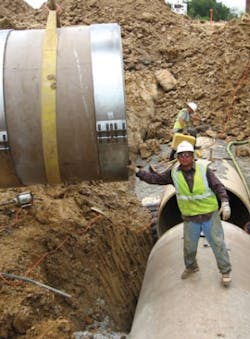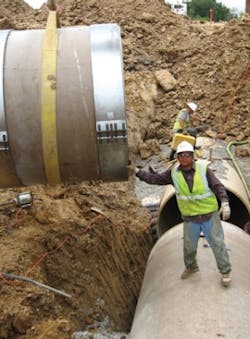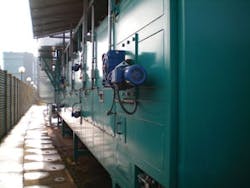By James A. Willson II and Kimberly Paggioli
Federal dollars allocated through the Georgia State Revolving Fund have been awarded to the City of Augusta to complete reconstruction of a portion of the city's sewer system. The project's old concrete pipe was installed in the early 1960s. In 2000, the city engaged Stevenson & Palmer Engineering's Augusta office to perform a condition assessment of the troubled line. Engineers found that hydrogen sulfide and sulfuric acid had attacked the crown of the pipe, weakening the structure.
Stevenson & Palmer was subsequently engaged to design a new gravity sewer for the line with this chemistry in mind. The recommendation was made to replace almost six miles of the city's sewer system and abandon in-place the existing concrete sewer. The city did not have the funds to replace this entire length at one time, so the project was divided into two phases.
Pipe Selection
A number of factors led to Stevenson & Palmer specifying Hobas centrifugally cast fiberglass reinforced polymer mortar (CCFRPM) pipe for the replacement line. CCFRPM pipe is highly resistant to the H2S and H2SO4 combination that caused the corrosive damage to the concrete pipe. The pipe's lighter weight compared to concrete and ductile iron makes transportation and installation easier and more economical than fully lined concrete.
In Augusta, Ga., a short section of the Hobas sewer main pipe with closure couplings is lowered into the trench.
Although the CCFRPM pipe was expected to be bid at a higher material cost per linear foot, the additional installation costs associated with HDPE pipe would have made that pipe material the more expensive option.
Phase I
The City of Augusta bid Phase I in late 2006, with Oscar Renda Contracting (ORC) of Roanoke, TX, winning the $16 million contract to replace over 13,000 linear feet of the line. Work began in February 2007, in the mid-city area and proceeded southward through a light commercial zone. The line crossed Gordon Hwy./US 1 toward Doug Barnard Pkwy./GA SR Spur 56, following that route to its intersection with Dan Bowles Rd. The contractor installed over 6,000 linear feet of 63-inch diameter and 7,200 linear feet of 72-inch diameter pipe prior to decommissioning the existing 54-inch concrete pipe.
The ORC crew laid the new line parallel to the old line, at a distance of approximately 10 to 15 feet. The old line was replaced only at connection points: two main line junction boxes and three 36-inch tributaries, according to ORC project manager Dennis Bailey. About 6,300 feet (almost 1.2 miles) of the 63-inch diameter pipe were installed directly under New Savannah Rd.
After lowering the pipe, a pushing frame was used to place it into the tunnel.
"We went right down the center of the street with it," Bailey said. "We had to keep access to all the businesses and residences, so we closed portions of the street and then backfilled with a temporary surface."
The faster installation of CCFRPM pipe as compared to other materials shortened the inconvenience for local traffic by several weeks.
Southland Contracting, Fort Worth, TX, was subcontracted to perform the directional bores: a 280-foot bore took the 72-inch diameter line under Gordon Hwy./US 1; a 72-inch casing was bored 160 feet for 63-inch diameter pipe under the Norfolk Southern railroad tracks, and a 116-foot bore for 48-inch diameter pipe ran under Doug Barnard Pkwy./GA SR Spur 56.
Phase 2
The City of Augusta's plans for Phase 2, the completion of the replacement project, is currently under contract approval and will be constructed by John D. Stephens of Lawrenceville, GA. The city's funding resources have been focused on upgrading the Messerly Wastewater Pollution Control Facility, where the main interceptor sanitary sewer discharges for final treatment.
Stevenson & Palmer Engineering helped Augusta complete an application to receive funding under the American Recovery and Reinvestment Act (ARRA) economic stimulus for Phase 2 as a State Revolving Fund (SRF) project. Due to the competitive nature of the ARRA program, the city was not selected for stimulus funds, but did qualify for a long-term, low-interest loan from Georgia Environmental Facilities Authority, backed by federal funds.
Phase 2, which begins where Phase 1 ended, at the intersection of Doug Barnard Pkwy./GA SR Spur 56 and Dan Bowles Rd., will continue southeastward, terminating at the headworks of the Messerly Plant near Augusta Regional Airport at Bush Field. It will involve the installation of approximately 9,000 linear feet of 84-inch diameter and about 5,200 linear feet of 72-inch diameter pipe. Two bores will be required. One will be a 210-foot direct jack and tunnel of 72-inch diameter pipe under Rocky Creek. The other will be a 335-foot direct bore that will take 84-inch diameter pipe under Federal Highway I-520, the Bobby Jones Expressway.
The Phase 2 project, which bid July 14, 2009, was expected to break ground in February 2010. John D. Stephens' bid came in well below the engineer's opinion. Probably the changes in the economy since Phase 1 was built led to the bids being considerably lower than was initially budgeted. WW
About the Authors:James A Willson II, P.E., CSI, CCS, is Vice President, Augusta Office Regional Manager, of Stevenson & Palmer Engineering, Inc. Kimberly Paggioli, P.E., is vice president of Marketing and Quality Control for Hobas Pipe USA.
More WaterWorld Current Issue Articles
More WaterWorld Archives Issue Articles





